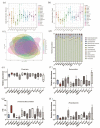Exploring the Dose-Effect Relationship of Bifidobacterium longum in Relieving Loperamide Hydrochloride-Induced Constipation in Rats through Colon-Released Capsules
- PMID: 37047557
- PMCID: PMC10095166
- DOI: 10.3390/ijms24076585
Exploring the Dose-Effect Relationship of Bifidobacterium longum in Relieving Loperamide Hydrochloride-Induced Constipation in Rats through Colon-Released Capsules
Abstract
Constipation is a common disease affecting humans. Bifidobacterium longum is reportedly effective in relieving constipation. Current studies generally focus on the dose-response relationship of oral doses; however, the dose-effect relationship of B. longum in the colon, which is the primary site where B. longum exerts constipation-relieving effects, to treat constipation has not been studied. Herein, three strains of B. longum (FGSZY6M4, FJSWXJ10M2, and FSDJN6M3) were packaged in colon-released capsules to explore the dose-effect relationship in the colon. For each strain, three groups of capsules (104, 106, and 108 CFU/capsule, respectively) and one group of free probiotics (108 CFU/mL) were used to explore the colonic dose effect of B. longum. The results showed that the three strains of B. longum improved fecal water content and promoted intestinal motility by regulating gastrointestinal peptide (MTL, GAS, and VIP), aquaporin-3, and 5-hydroxytryptamine levels while promoting gastrointestinal motility and relieving constipation by regulating the intestinal flora composition of constipated rats and changing their metabolite content (short-chain fatty acids). Among the three free bacterial solution groups (108 CFU/mL), FGSZY6M4 was the most effective in relieving constipation caused by loperamide hydrochloride in rats. The optimal effective dose of each strain was 6M4 (104 CFU/day), 10M2 (106 CFU/day), and S3 (108 CFU/day) of the colon-released capsules. Therefore, for some effective strains, the dose of oral probiotics can be reduced by colon-released capsules, and constipation can be relieved without administering a great number of bacterial solutions. Therefore, investigating the most effective dose of B. longum at the colon site can help to improve the efficiency of relieving constipation.
Keywords: Bifidobacterium longum; colon-released capsules; constipation; dose–effect relationship.
Conflict of interest statement
The authors declare no conflict of interest.
Figures







Similar articles
-
Bifidobacterium longum subsp. longum relieves loperamide hydrochloride-induced constipation in mice by enhancing bile acid dissociation.Food Funct. 2025 Jan 2;16(1):297-313. doi: 10.1039/d4fo04660a. Food Funct. 2025. PMID: 39668691
-
Bifidobacterium longum S3 alleviates loperamide-induced constipation by modulating intestinal acetic acid and stearic acid levels in mice.Food Funct. 2024 Jun 4;15(11):6118-6133. doi: 10.1039/d4fo00695j. Food Funct. 2024. PMID: 38764333
-
Bifidobacterium longum relieves constipation by regulating the intestinal barrier of mice.Food Funct. 2022 May 10;13(9):5037-5049. doi: 10.1039/d1fo04151g. Food Funct. 2022. PMID: 35394000
-
Bifidobacterium longum W11: Uniqueness and individual or combined clinical use in association with rifaximin.Clin Nutr ESPEN. 2021 Apr;42:15-21. doi: 10.1016/j.clnesp.2020.12.025. Epub 2021 Feb 17. Clin Nutr ESPEN. 2021. PMID: 33745570 Review.
-
How do probiotics alleviate constipation? A narrative review of mechanisms.Crit Rev Biotechnol. 2025 Feb;45(1):80-96. doi: 10.1080/07388551.2024.2336531. Epub 2024 May 6. Crit Rev Biotechnol. 2025. PMID: 38710624 Review.
Cited by
-
Efficacy of a postbiotic and its components in promoting colonic transit and alleviating chronic constipation in humans and mice.Cell Rep Med. 2025 May 20;6(5):102093. doi: 10.1016/j.xcrm.2025.102093. Epub 2025 Apr 25. Cell Rep Med. 2025. PMID: 40286792 Free PMC article. Clinical Trial.
-
Effect of Probiotic Dose Escalation on Gut Microbiota and Clinical Outcomes in Preterm Infants-A Systematic Review.Children (Basel). 2023 Oct 20;10(10):1710. doi: 10.3390/children10101710. Children (Basel). 2023. PMID: 37892373 Free PMC article. Review.
-
Weizmannia Coagulans BC99 Prevents Loperamide-Induced Functional Constipation in Mice Through Increased Intestinal Peristalsis and Modulation of Gut Microbiota Dysbiosis.Nutrients. 2025 May 20;17(10):1729. doi: 10.3390/nu17101729. Nutrients. 2025. PMID: 40431468 Free PMC article.
-
Effect of Probiotics in Stress-Associated Constipation Model in Zebrafish (Danio rerio) Larvae.Int J Mol Sci. 2024 Mar 25;25(7):3669. doi: 10.3390/ijms25073669. Int J Mol Sci. 2024. PMID: 38612481 Free PMC article.
-
Impact of resistant starch type 3 on fecal microbiota and stool frequency in Thai adults with chronic constipation randomized clinical trial.Sci Rep. 2024 Nov 14;14(1):27944. doi: 10.1038/s41598-024-79465-1. Sci Rep. 2024. PMID: 39543201 Free PMC article. Clinical Trial.
References
-
- Krammer H.-J., von Seggern H., Schaumburg J., Neumer F. Effect of Lactobacillus Casei Shirota on Colonic Transit Time in Patients with Chronic Constipation. Coloproctology. 2011;33:109–113. doi: 10.1007/s00053-011-0177-0. - DOI
MeSH terms
Substances
Grants and funding
LinkOut - more resources
Full Text Sources
Other Literature Sources

